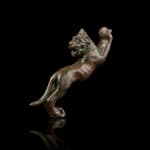Etruscan
An Etruscan bronze lion handle, early 5th century BC
Bronze
Length: 6.6 cm
The animated lion is shown springing forward with his held turned back. The face and neck is characterised by decoration depicting the lion's fur and mane, with his mouth open...
The animated lion is shown springing forward with his held turned back. The face and neck is characterised by decoration depicting the lion's fur and mane, with his mouth open showing his tongue. The body is defined by strong musculature.
Provenance
Private collection, Zurich, Switzerland, acquired in the 1990s
Cahn, Basel, Auktion 5, 16 September 2010, lot 219
Private collection, Switzerland, acquired from the above
Literature
This lion would originally have formed part of a handle attached to a larger bronze vessel, a prong can still be found on the front paws that would have been used for attachment. Such attachments have their origins in the art of the Near East, but in the Orientalising period of the 8th-7th centuries, we see such subjects and forms travelling to Greece and on to Etruria. The leaping lion appears on bronze handles from Olympia and other Greek sites, but the style of this lion and its facial features indicates an Etruscan origin.The Etruscans were master metalsmiths and ready access to copper and iron, which were abundant in Etruria, led to the widespread production of small, finely crafted bronze objects that served both decorative and functional purposes. For a similar example see, the Walters Art Museum, acc. no. 54.89. For further discussion of lions in Etruscan art, see William Llewelyn Brown, The Etruscan Lion, Oxford, 1960.



